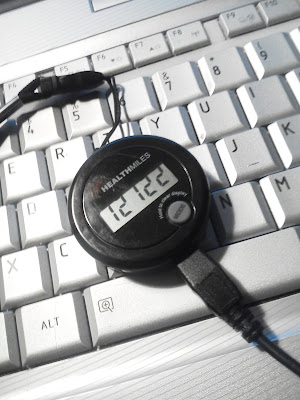SWG2L: Cooking
If we were to really get into cooking, I could probably start a whole new blog. I love to cook. I started learning when I was physically able to stir and I love experimenting now (which leads to a lot more interesting food stories than most people want to hear). Instead, we’re going to do what is mostly the norm with The Guide and cover the basics.
Contrary to popular belief, there isn’t a lot of "stuff" necessary. My dishes haven’t changed a lot since college (with the exception of my stand mixer -- a dream come true). I made it through college with:
- One mixing bowl.
- One frying pan.
- One sauce pan.
- One cookie sheet.
- Two bread loaf pans.
- One wooden spoon.
- One spatula.
- One set of silverware (stolen from the cafeteria), a plate, and a bowl. [Author's note: This blog does not condone stealing silverware or anything else, even if it's from a place that takes the equivalent of a part- or full-time job's paycheck from you for several years.]
Almost all of it was donated to me (my mom or grandmother unloading their old, retired dishes) and anything extra I found at thrift stores or on sale at Target.
Now I buy things here and there or ask for them for Christmas. As a single chick, I don’t expect to be able to register for a whole new kitchen any time soon (nor do I want to if I’m ever given the opportunity, but that’s a different story altogether) so I’m slowly building my collection. I try to stay away from one-purpose-only things because they tend to clutter up a kitchen more than help it. (I do have a garlic press, though, because I really don’t enjoy mincing garlic.) I also still frequent thrift stores; at a good secondhand store you can find most kitchen items and spend well under half what you would for something new.
Far more important, however, are your ingredients.
Food I am almost never without:
1. Standard baking ingredients.
- Flour (all-purpose and wheat)
- Sugar (four kinds, actually -- standard white, standard brown, powdered, and raw)
- Baking powder, baking soda, and cornstarch
- Stick butter/margarine
- Yeast
2. Some variety of vegetables -- usually spinach, cucumbers, tomatoes, potatoes, and an onion. This differs from week to week according to what’s in season and what I’m in the mood for, but I almost always have those five.
3. Some variety of fruit -- usually apples, oranges, and lemons. Again, this varies by what’s in season and what I’m craving.
4. Essential canned foods -- tomato sauce & diced tomatoes, a few soups.
5. Frozen meat (hamburger, breakfast sausage, chicken breasts).
6. Garlic in clove form.
7. Vegetable and olive oils.
8. Flour tortillas.
9. A couple of snack foods (I try to keep these to a minimum so I don’t always resort to eating junk).
10. Dark chocolate (60% cacao or better).
11. Eggs.
12. A general pasta variety (macaroni, fettuccine, spaghetti, and egg noodles).
13. Cereal (usually two or three kinds so I don’t get bored) and oatmeal.
14. Milk.
15. A bottle of cheap red wine.
Keep in mind that this list didn’t apply while I was at school. I had most of the baking ingredients, eggs, a couple of veggies, a box of cereal, some pasta, and usually some meat scavenged from a relative here and there. [Author’s note: That sounds really wrong. I have cattle ranching relatives who were usually more than willing to give me free beef. I’m not a cannibal.] If I made something special, I had to go grocery shopping first.
This list is fairly specific to me; I bake my own bread (I haven't bought a regular store loaf in almost three years) and I use red wine in spaghetti sauce and as a marinade.
As per usual, though, you need somewhere to start. Given my love for both cooking and books, I have a growing collection of cookbooks. Betty Crocker puts out a good one for learning, as does Better Homes & Gardens. And if you're just looking for new recipes, I have to recommend one of my favorite bloggers, the Pioneer Woman. If you're looking for a very specific recipe, you can easily Google it by typing in as many of the ingredients you can remember and hitting "search." (I look up lemon chicken that way every time I make the stuff.)
Once you have these basics covered, you can make almost anything. I recommend finding three or four dishes that you really like, each preferably with a different base (pasta, rice, potatoes, lettuce, whatever). You can build off these as you get more comfortable and adventuresome.
There you have it. Don't be afraid to turn your kitchen into your lab (and your friends into lab rats -- believe me, they'll be okay with it). And make sure you know how to shut your smoke alarm off for the first time you get distracted while cooking sausage. Or the eighty-fourth time.
Contrary to popular belief, there isn’t a lot of "stuff" necessary. My dishes haven’t changed a lot since college (with the exception of my stand mixer -- a dream come true). I made it through college with:
- One mixing bowl.
- One frying pan.
- One sauce pan.
- One cookie sheet.
- Two bread loaf pans.
- One wooden spoon.
- One spatula.
- One set of silverware (stolen from the cafeteria), a plate, and a bowl. [Author's note: This blog does not condone stealing silverware or anything else, even if it's from a place that takes the equivalent of a part- or full-time job's paycheck from you for several years.]
Almost all of it was donated to me (my mom or grandmother unloading their old, retired dishes) and anything extra I found at thrift stores or on sale at Target.
Now I buy things here and there or ask for them for Christmas. As a single chick, I don’t expect to be able to register for a whole new kitchen any time soon (nor do I want to if I’m ever given the opportunity, but that’s a different story altogether) so I’m slowly building my collection. I try to stay away from one-purpose-only things because they tend to clutter up a kitchen more than help it. (I do have a garlic press, though, because I really don’t enjoy mincing garlic.) I also still frequent thrift stores; at a good secondhand store you can find most kitchen items and spend well under half what you would for something new.
Far more important, however, are your ingredients.
Food I am almost never without:
1. Standard baking ingredients.
- Flour (all-purpose and wheat)
- Sugar (four kinds, actually -- standard white, standard brown, powdered, and raw)
- Baking powder, baking soda, and cornstarch
- Stick butter/margarine
- Yeast
2. Some variety of vegetables -- usually spinach, cucumbers, tomatoes, potatoes, and an onion. This differs from week to week according to what’s in season and what I’m in the mood for, but I almost always have those five.
3. Some variety of fruit -- usually apples, oranges, and lemons. Again, this varies by what’s in season and what I’m craving.
4. Essential canned foods -- tomato sauce & diced tomatoes, a few soups.
5. Frozen meat (hamburger, breakfast sausage, chicken breasts).
6. Garlic in clove form.
7. Vegetable and olive oils.
8. Flour tortillas.
9. A couple of snack foods (I try to keep these to a minimum so I don’t always resort to eating junk).
10. Dark chocolate (60% cacao or better).
11. Eggs.
12. A general pasta variety (macaroni, fettuccine, spaghetti, and egg noodles).
13. Cereal (usually two or three kinds so I don’t get bored) and oatmeal.
14. Milk.
15. A bottle of cheap red wine.
Keep in mind that this list didn’t apply while I was at school. I had most of the baking ingredients, eggs, a couple of veggies, a box of cereal, some pasta, and usually some meat scavenged from a relative here and there. [Author’s note: That sounds really wrong. I have cattle ranching relatives who were usually more than willing to give me free beef. I’m not a cannibal.] If I made something special, I had to go grocery shopping first.
This list is fairly specific to me; I bake my own bread (I haven't bought a regular store loaf in almost three years) and I use red wine in spaghetti sauce and as a marinade.
As per usual, though, you need somewhere to start. Given my love for both cooking and books, I have a growing collection of cookbooks. Betty Crocker puts out a good one for learning, as does Better Homes & Gardens. And if you're just looking for new recipes, I have to recommend one of my favorite bloggers, the Pioneer Woman. If you're looking for a very specific recipe, you can easily Google it by typing in as many of the ingredients you can remember and hitting "search." (I look up lemon chicken that way every time I make the stuff.)
Once you have these basics covered, you can make almost anything. I recommend finding three or four dishes that you really like, each preferably with a different base (pasta, rice, potatoes, lettuce, whatever). You can build off these as you get more comfortable and adventuresome.
There you have it. Don't be afraid to turn your kitchen into your lab (and your friends into lab rats -- believe me, they'll be okay with it). And make sure you know how to shut your smoke alarm off for the first time you get distracted while cooking sausage. Or the eighty-fourth time.


Comments